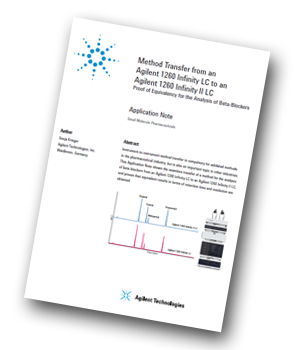Agilent Technologies has produced an application note that shows the seamless transfer of a method for the analysis of beta-blockers from an Agilent 1260 Infinity LC to an Agilent 1260 Infinity II LC. It proves that equivalent results in terms of retention time and resolution are obtained.
 Introduction
Introduction
Method transferability from one instrument to another is important for laboratories throughout different industries. In the pharmaceutical industry, instrument-to-instrument method transferability is compulsory for validated methods. One example for the need to transfer methods from one instrument to another is the method transfer to new LC instruments, such as the Agilent 1260 Infinity II LC. This Application Note shows the seamless method transfer from an Agilent 1260 Infinity LC to a 1260 Infinity II LC for the analysis of metoprolol, pindolol, propranolol, and timolol.
Results and Discussion
The method was transferred to a 1260 Infinity II LC including an Agilent 1260 Infinity II Binary Pump for proof of equivalency. In addition, the method was transferred to UHPLC conditions optimized for speed using the 1260 Infinity II LC. The method for the analysis of beta‑blockers was transferred without any changes to the 1260 Infinity II LC.
Conclusion
The transfer of the method for the analysis of beta-blockers from an Agilent 1260 Infinity LC to the Agilent 1260 Infinity II LC showed a maximum retention time deviation of 1.0 %, and equivalent results in terms
of peak resolution. This proves the equivalency of the 1260 Infinity II LC compared to the 1260 Infinity LC for the analysis of beta-blockers. By making full use of the pressure range of the 1260 Infinity II LC and transfer of the method for the analysis of beta-blockers to UHPLC conditions optimized for speed, the analysis time and solvent use were greatly reduced.




